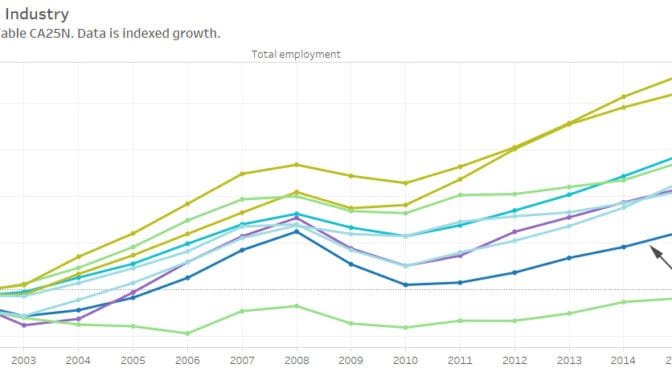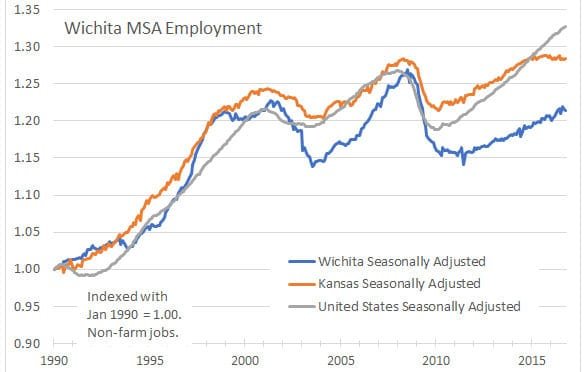In Wichita, we see another example of how once government starts a surveillance program, it probably won’t produce the promised results, yet will be expanded.
This week the Wichita City Council will consider adding more surveillance cameras to Old Town. City documents don’t specify how many video cameras will be installed as part of the $618,261 program (for one-time installation costs only), except that it may be “as many as 100.” The city is also asking council members to pass an ordinance with bonding authority of up to $750,000 to pay for this project. In other words, the city is borrowing to pay for this system.1
This proposed expansion of camera surveillance is another expansion of police powers in Wichita at the loss of civil liberties.2 In 2014 the city designated Old Town an “entertainment district,” giving the city increased powers to attempt to control crime.3 Critics are concerned that the extra enforcement measures granted to entertainment districts are discriminatory to certain minority groups.4
This proposed expansion of cameras is not likely to be the last. Wichita’s police chief is seeking to add more surveillance and cameras.5
Across the county, those concerned with the loss of civil liberties and privacy are concerned about the expansion of the surveillance state. Adding irony to this debate are the remarks of Wichita City Council Member Janet Miller (district 6, north central Wichita). She called the addition of the new cameras “huge” and “exciting,” adding that she is “very, very happy” at their addition.6 The irony is that she would insist that she is a protector of civil rights.
Why are civil rights important in this matter? Discussing this matter on Facebook, one local political activist wondered, “How long before someone is being blackmailed with footage from a police surveillance cam, for stumbling down the road, or some other harmless but embarrassing scenario?”
In response, I added, “Or blackmailed for marital infidelity, or entering a gay bar, a marijuana dispensary, a church, an STD clinic, an abortion doctor’s office, or maybe being spotted dropping off an anonymous tip to the newspaper.” (Well, we don’t have marijuana dispensaries, but we do have complimentary stores.) (There are two newspapers in Old Town. Well, one is across the street from Old Town, but is moving into Old Town.)
We have to wonder whether the cameras work as advertised. The website You Are Being Watched, a project of the American Civil Liberties Union, comes to this conclusion: “An increasing number of American cities and towns are investing millions of taxpayer dollars in surveillance camera systems. But few are closely examining the costs and benefits of those investments, or creating mechanisms for measuring those costs and benefits over time. There is extensive academic literature on the subject — studies carried out over many years — and that research demonstrates that video surveillance has no statistically significant effect on crime rates. Several studies on video surveillance have been conducted in the UK, where surveillance cameras are pervasive. The two main meta-analyses conducted for the British Home Office (equivalent to the US departments of Justice and Homeland Security) show that video surveillance has no impact on crime whatsoever. If it did, then there would be little crime in London, a city estimated to have about 500,000 cameras.”
An irony is that law enforcement likes recording citizens, but not the other way around. As John Stossel has noted, police don’t like to be recorded. In some states its a crime to tape a police officer making an arrest. A video excerpt from Stossel’s television shows the attitudes of police towards being recorded. At Reason Radley Balko details the problem, writing “As citizens increase their scrutiny of law enforcement officials through technologies such as cell phones, miniature cameras, and devices that wirelessly connect to video-sharing sites such as YouTube and LiveLeak, the cops are increasingly fighting back with force and even jail time—and not just in Illinois. Police across the country are using decades-old wiretapping statutes that did not anticipate iPhones or Droids, combined with broadly written laws against obstructing or interfering with law enforcement, to arrest people who point microphones or video cameras at them. Even in the wake of gross injustices, state legislatures have largely neglected the issue.”
Writing for Cato Institute, Julian Sanchez noted:
It is also unlikely that cameras will be especially helpful in deterring such attacks. Even when it comes to ordinary crime — where the perpetrators are generally motivated by the desire to make a quick buck without getting caught — studies have been mixed and inconclusive about the value of CCTV cameras as a crime deterrent.
Some show significant declines in crime in some regions of cities with camera networks, which may be attributable to the cameras — but many show no discernible effect at all.
Of note, one country with a government that really likes surveillance cameras is China.
—
Notes
- Wichita City Council agenda for February 14, 2017. ↩
- Weeks, Bob. Surveillance state arrives in Wichita. https://wichitaliberty.org/liberty/surveillance-state-arrives-in-wichita/. ↩
- Weeks, Bob. Wichita seeks to form entertainment district. https://wichitaliberty.org/wichita-government/wichita-seeks-form-entertainment-district/. ↩
- Class-action lawsuit alleges racial discrimination at Power & Light. Kansas City Star, March 10, 2014. http://www.kansascity.com/news/local/article341880/Class-action-lawsuit-alleges-racial-discrimination-at-Power–Light.html. ↩
- Finger, Stan. Police seek answers, reversal as aggravated assaults surge. Wichita Eagle, February 10, 2017. http://www.kansas.com/news/local/crime/article132071799.html. ↩
- Lefler, Dion. Wichita working to bring Old Town under camera surveillance. Wichita Eagle, February 10, 2017. http://www.kansas.com/news/politics-government/article131952109.html. ↩





















